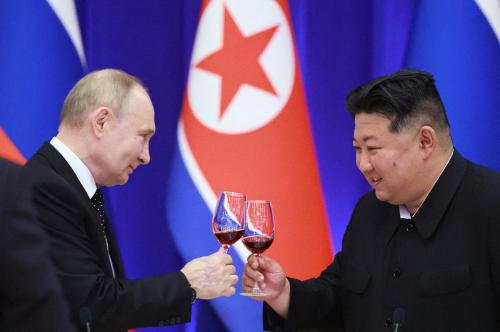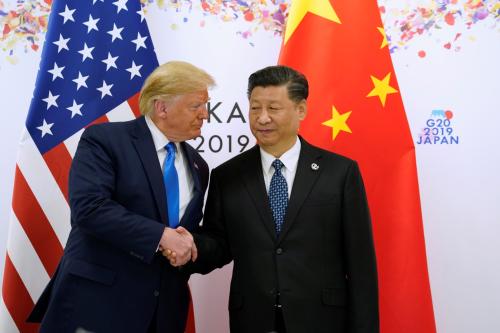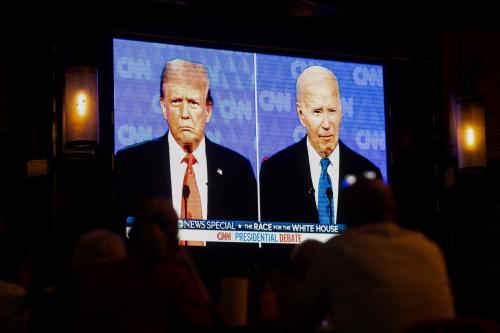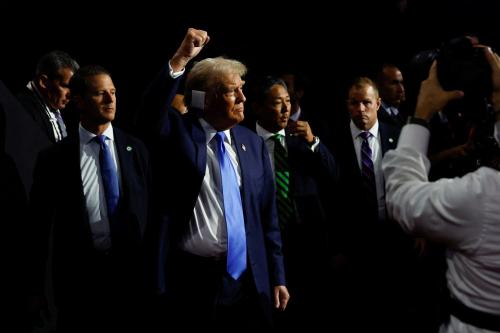It has become almost axiomatic to pronounce—and would initially seem difficult to dispute—that a U.S. “consensus” on China policy has formed. The Trump administration concluded, and the Biden administration agrees, that China seeks to overtake the United States as the world’s preeminent power—a conclusion that offers a rare point of foreign policy continuity between the two administrations. In addition, Republican and Democratic members of Congress alike agree that Beijing is Washington’s foremost geopolitical competitor. And especially over the past decade, the United States has taken a series of steps to offset China’s military modernization, limit its ability to access high-end technological components that could fuel that push, and bolster Washington’s own alliances and partnerships in Europe and Asia.
But this putative consensus is limited at best because it downplays vigorous debates within the U.S. policy community over three categories of questions:
- Analytical: How should the United States characterize the competitive challenge that China poses to U.S. influence and the incumbent international order?
- Historical: Was U.S. policy toward China misguided until recently?
- Prescriptive: What should U.S. policy toward China aim to achieve?
Underlying these questions is a broad range of views as to how concerned the United States should be and what actions it should take to compete with China more effectively.
These debates have come into sharp focus with the publication of and responses to an essay by Matt Pottinger, a former deputy national security advisor during the Trump administration, and Mike Gallagher, a former co-chair of the House Select Committee on Strategic Competition Between the United States and the Chinese Communist Party. These debates are more visible on Capitol Hill and in exchanges within the outside policy community than they are in analyses of dynamics within the executive branch. The president and the president’s key advisors ultimately carry outsized weight in shaping America’s approach toward China.
However one parses the contours of these debates, insisting that a consensus exists inhibits a fuller consideration of America’s policy options. As the United States and China navigate what is likely to be a prolonged, if not indefinite, period of heightened tensions, it behooves the U.S. policy community to address the challenges that it believes China’s behaviors and ambitions pose for U.S. interests in a way that strengthens international security. Foreclosing policy options in the service of abiding by a thin, brittle “bipartisan consensus” only undercuts America’s ability to accomplish this objective.
Analytical
Is China’s power plateauing or still growing apace?
Depending on which data points one adduces, one can make a plausible case for each hypothesis. For example, China is struggling to sustain an annual growth rate of 5%. Factors including demographic decline and shrinking foreign investment flows will lower that figure over time (the International Monetary Fund forecasts that China’s annualized growth will fall to 3.3% by 2029). On the other hand, Beijing is making impressive strides in developing leading-edge technologies, including those that will undergird the global energy transition, prompting many Western companies to fear for their competitiveness and market shares.
Observers who subscribe to the “peak China” hypothesis believe that the world is entering a period of heightened risks, one during which Beijing may be more willing to lash out to secure what it considers to be its core interests before its relative power vis-à-vis Washington begins to wane. Proponents of this view are most concerned about the possibility that China will take drastic military actions this decade, most concerningly an invasion of Taiwan. They are relatively less anxious about the competitive challenge that China will pose over the medium to long run, given their assessment that China’s mounting national challenges will degrade its capacity to achieve its ambitions over time.
Among those who assess that China is continuing to rise in relative—if not necessarily absolute—terms, some fear that Beijing may succeed in eroding the U.S.-led order and implementing an alternative vision. Others in this camp conclude that China, while a formidable and multidimensional competitor, is not poised to overtake the United States for global preeminence. They note that Beijing faces daunting domestic challenges and an external environment that limits, if not precludes, the possibility of Chinese hegemony in Asia, let alone globally. For starters, China’s period of rapid economic expansion has passed. Slowing productivity, a decreasing ratio between its working-age and elderly populations, and growing domestic debt will hasten its slowdown, as will Chinese President Xi Jinping’s prioritization of political control over economic growth.
In addition, China’s strategic environment constrains its capacity to assert greater regional influence; it is surrounded by highly capable countries that aim to avoid a China-dominated Asia—including Japan, South Korea, Australia, India, and Vietnam—and it must contend with Washington’s enduring Pacific presence, which is growing as the United States becomes more concerned about China’s ambitions in Asia. And while China is presently amassing greater influence in the developing world, it remains to be seen whether that trend will hold as Beijing’s internal and external difficulties grow in number and severity. For those who are partial to this line of thinking, it is telling that China has scaled back funding for Xi’s flagship geoeconomic project, the Belt and Road Initiative, as that undertaking has elicited growing criticism in the developing world.
From the perspective of a U.S. foreign policy observer, one’s assessment of China’s trajectory influences not only one’s forecast of the kinds of challenges that China will present to the United States, but also one’s judgment about the urgency that Washington must exhibit in meeting them. Some members of the U.S. policy community believe that China poses an imminent, sweeping threat to American interests and values. They fear that U.S. officials do not appreciate the gravity of the challenge, understand how much effort will be needed to prepare Americans for a new twilight struggle, and have the discipline to engage in the ruthless tradeoffs that will be necessary to prioritize such a competition. Others believe that a Manichean approach is likely to induce anxiety, stoke overreaction, and inflame racism against ethnic Chinese members of American society. To them, a more balanced, confident posture that upholds American values is likely to prove more effective at sharpening a contrast with China’s vision for international order, thus enabling the United States to attract greater support from allies and partners for long-term strategic competition.
How will China’s economic and foreign policies evolve when Xi is no longer at the helm?
Some observers believe that Xi has stamped an indelible imprimatur on his country’s trajectory, constraining his successor’s ability to change course. Others take a longer view of China’s political evolution over the past three-quarters of a century, noting that it has had very different kinds of leaders during that time—compare, say, a highly ideological figure such as Mao Zedong and a more reform-minded one such as Deng Xiaoping.
The more one believes that China is on an irreversible path—that it will indefinitely grow more authoritarian at home and assertive abroad—the more likely one may be to recommend commensurately unyielding U.S. countermeasures. If, however, one ventures that a post-Xi China might adjust its course by allowing for more political liberalization and pursuing less aggressive policies toward advanced industrial democracies, one might not be as quick to embrace calls for risky gambles—such as working to hasten regime collapse in China—or frame competition in existential terms.
Which periods from history can help to illuminate how the U.S.-China relationship is unfolding?
Most observers cite the Cold War, America’s only experience with long-term strategic competition. Others find the run-up to World War I to be more relevant. Meanwhile, a thought-provoking analysis by the RAND Corporation last year concluded that the great-power rivalries of the past two centuries do not offer much guidance, venturing that the trajectory of U.S.-China relations will entail “a blend of some aspects of modern life and a much more substantial attenuation or regression of other aspects” that features “weakening states, fragmenting societies, imbalanced economies, pervasive threats, and the informalization of warfare.” One’s historical analysis influences one’s policy recommendations; those who see the emergence of a “new Cold War,” for example, are more likely to advocate an updated U.S. policy of containment, while those who think that the Cold War analogy’s differences outweigh its similarities are more likely to recommend measures that will help to manage a competitive coexistence.
Historical
Did the United States get China “wrong?”
According to a prevalent narrative, America “lost” China in 1949, when Mao’s Communist forces expelled Chiang Kai-shek’s Kuomintang forces to Taiwan. In this telling, the Nixon administration committed the “original sin” of China policy by initiating Washington’s opening to Beijing in 1972. Subsequent administrations compounded that alleged error by attempting to integrate China into the postwar order and cultivating economic interdependence between the two countries, naïvely hoping that China’s economic development would hasten political change inside China and/or structural behavioral change. At the core of this debate over America’s erstwhile approach to China is a disagreement over the extent of U.S. agency: could an alternative course of policy have slowed, if not forestalled, the emergence of a competitive challenge from China?
As Xi began consolidating political power and pursuing a more assertive foreign policy, many observers concluded that the United States needed to update its assumptions about China’s intentions. Some argued that the United States needed to dispense with a policy that, in their assessment, had enabled the emergence of America’s most formidable rival and instead adopt a more confrontational approach to limit China’s continued rise. Others disputed the suggestion that Washington could control Beijing’s trajectory so easily, challenging critics of America’s past approach to spell out the counterfactual and explain how the United States would be better off if it had sought to confront China earlier and arrest its rise. They argued that the United States should modify but not abandon altogether a bipartisan approach that it had pursued over four decades: develop functional relations with China while investing in America’s competitiveness at home, building out a network of allies and partners—especially in Asia—and protecting the global commons.
If one believes that the United States naïvely enabled the rise of what is now its only near-peer competitor, then one might believe that a fundamental reset of its policy—aimed at reducing China’s capacity to challenge U.S. leadership—is necessary. If, however, one questions whether the United States could ever have realistically expected to prevent China’s rise, then one might ask whether a sharp policy shift toward open confrontation would carry more risks than benefits, potentially doing great harm to U.S.—and global—security and prosperity in the process.
Prescriptive
How should the United States adjust its economic relationship with China?
The COVID-19 pandemic and Russia’s invasion of Ukraine have convinced most observers that the United States needs to do more to reduce its reliance on China for vital commodities and prevent U.S. companies, allies, and partners from supporting Beijing’s military modernization. Some believe that the United States should revoke permanent normal trade relations with China and attempt to decouple, arguing that interdependence has given Beijing too much influence over the U.S. economy and enabled it to build up its military using U.S.-supplied inputs. Others contend that such efforts would hurt the U.S. economy without addressing the underlying stressors in the U.S.-China relationship, noting that the Trump administration’s tariff campaign hurt U.S. consumers, did not create new jobs, and did not compel China to implement structural economic reforms. There is a debate not only between proponents of decoupling and de-risking, but also among de-riskers, who question how far and how quickly the United States should go in paring back economic ties with China.
What policies should the United States pursue to deter China’s use of force against Taiwan?
Some observers argue that the United States should abandon its 45-year-old policy of “dual deterrence” against threats to peace from either China or Taiwan in favor of a policy of strategic clarity, concluding that an explicit U.S. commitment to intervene militarily under any circumstance to defend Taiwan against a Chinese assault would have the greatest chance of deterring such an attack. Others conclude that maintaining dual deterrence offers the best hope of preserving peace and stability in the Taiwan Strait and that advancing this goal requires vigilance against any potential triggers of conflict, not just the risk of an all-out Chinese invasion of Taiwan. Some assert that America’s support for Ukraine is depleting the materiel that it can allocate to Taiwan. Others argue that maintaining support for Kyiv is essential to demonstrating that Washington will not tolerate great-power aggression to redraw international boundaries through the threat or use of force. This disagreement alone—over how best to avoid a catastrophic great-power war—should go a long way toward invalidating the notion of a China consensus.
How ubiquitously should the United States compete with China?
Some observers argue that Washington does not have the luxury of concentrating its strategic focus and resources narrowly on Asia, contending that an effort to do so would enable Beijing to erode U.S. influence in Latin America, Africa, and the Middle East. Others warn that, in dealing with a competitor that is far more economically powerful than the Soviet Union ever was, the United States will have to be more discriminating in wielding leverage.
Assessments of China’s overall strategic ambitions inform how one approaches questions of where and when Washington should push back on Beijing’s efforts to expand its influence. Some observers conclude that China wishes to become “a” world leader that exercises a greater say over events beyond its borders. Others assess that it intends to become “the” preeminent power, achieving “global hegemony of Chinese communism.”
The United States will need to decide which assertions of Chinese influence implicate its interests sufficiently to warrant a response. Participants in this debate dispute not only how interconnected various theaters of U.S.-China contestation are, but also how important it is for the United States to prioritize some over others. Relatedly, U.S. policymakers will need to develop a framework for identifying where and under what conditions coordination between Washington and Beijing could advance U.S. interests.
What should the United States try to accomplish in its relationship with China?
Some observers argue that it must “win” today’s strategic competition, arguing that the Chinese Communist Party poses an existential challenge to the democratic world’s interests and values. They contend that China’s political regime must be deposed, whether from within or without, and that Beijing needs to accept a constrained role in a U.S.-led international order. Others note that since China has significant sources of strength, it is unrealistic for Washington to dictate such an end state. They believe that the United States will have to manage this competition indefinitely and identify a range of steady states—that is, conditions of bilateral relations that, while not immutable, are expected to remain reasonably stable over the short to medium term. They posit that attempts to bring about regime collapse in China would harm U.S. interests without achieving their intended objectives—by rupturing the global economy; straining relations with allies and partners, none of which would support such efforts; and compelling the Chinese people to rally more squarely behind their leaders for standing up to a hostile foreign adversary. They assess that a core challenge for U.S. policymakers—beyond the foundational imperative of averting a third world war—is to determine how Washington can sustain a preponderance of influence on issues that implicate its top interests as Beijing takes steps that undercut them. Participants in this debate disagree over the lessons of history, the nature of the competitive challenge that China poses, and the extent of U.S. influence in shaping China’s trajectory.
One could easily extend the list of questions in each of the three aforementioned categories—analytical, historical, and prescriptive. Even this partial inventory, however, calls into question the suggestion of a China consensus.
How the relationship between the world’s two foremost powers evolves will go a long way toward determining the fate of the 21st century; in light of those stakes, the United States needs as expansive and inclusive of a debate as possible over the way forward, not one that stays confined within the lines of a supposed consensus.
-
Acknowledgements and disclosures
The authors would like to thank China Center intern Stephen Garrett for his assistance on this essay, as well as Adam Lammon for editing, Rachel Slattery for layout, and the two blind peer reviewers for their feedback.








Commentary
Questioning the presumption of a US “consensus” on China policy
July 15, 2024